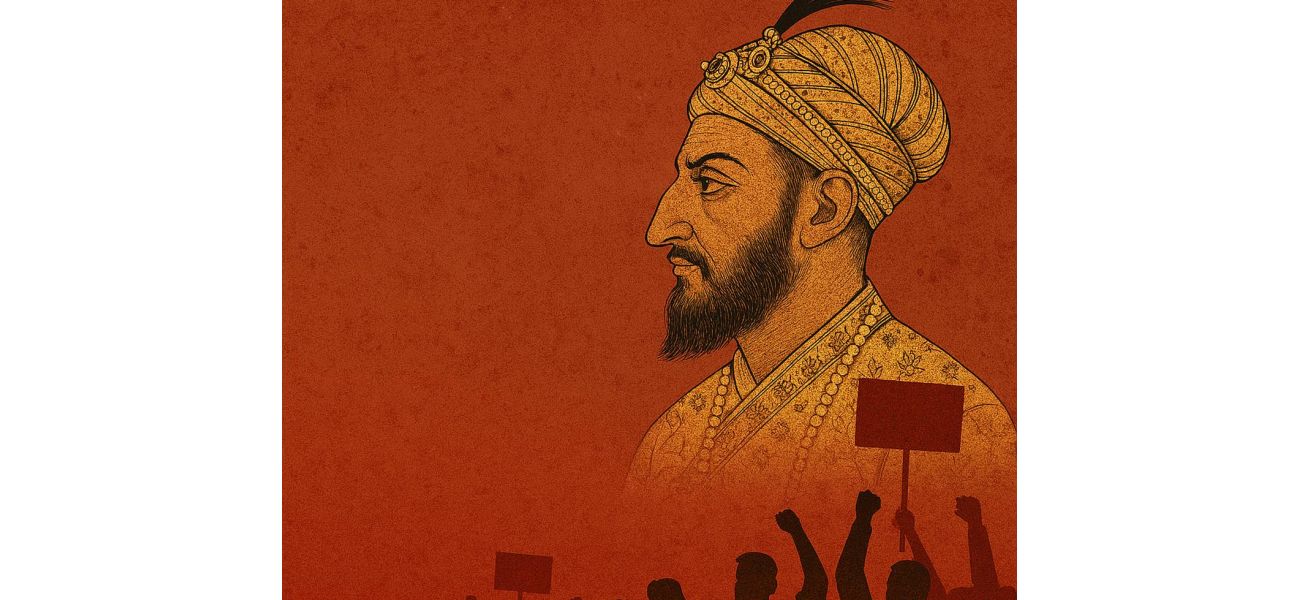What caused Aurangzeb's sudden significance in India?
Mumbai's Ram Navami procession turned into a concerning display of hate speech and offensive chants, raising concerns about communalization of public festivals. Thousands attended, mostly young men, but the atmosphere changed with hate-filled songs and slogans targeting communities and invoking historical grievances.
April 8th 2025.

The Ram Navami procession in Mumbai's western suburbs started out as a joyous celebration, but unfortunately, it quickly took a dark turn. What was meant to be a festive occasion soon became a disturbing display of hate speech and offensive slogans, once again highlighting the growing communalization of public events. Witnesses reported that thousands of people, mainly young men in their twenties and thirties, joined the procession, along with some older individuals and women.
However, things took a drastic turn when the loudspeakers started blaring out songs and slogans filled with hate and animosity. These were not just directed towards specific communities, but also invoked historical grievances centered around Aurangzeb, the 17th-century Mughal emperor. The chants and references to Aurangzeb were used to fuel communal tensions, painting him as a villain in today's political narrative. This trend of bringing back Aurangzeb's legacy in present-day provocations has become increasingly common, especially in political discussions and right-wing gatherings.
In recent years, Aurangzeb, the sixth Mughal emperor, has regained prominence in Indian public and political discourse. He has gone from being just one of the many historical rulers to a figure who evokes strong opinions, passionate debates, and ideological clashes. From changes in textbooks to controversies over the renaming of streets, from fiery political speeches to viral social media content, this ruler who reigned from 1658 to 1707 has become a central figure in national conversations. But why? What has caused this sudden resurgence of interest in Aurangzeb in India? Let us explore this phenomenon through the lenses of history, politics, and culture.
The latest wave of the Aurangzeb controversy started with the release of the upcoming Bollywood film, Chhaava, which portrays the life of Chhatrapati Sambhaji Maharaj and his encounter with Aurangzeb. This depiction sparked strong reactions, especially from right-wing groups. The Bajrang Dal further escalated the tensions by publicly calling for the removal of Aurangzeb's grave in Aurangabad, suggesting it should be taken down or "reclaimed" in some way. This rhetoric soon spilled over into the streets, leading to communal tensions, particularly in Maharashtra. Provocative slogans, hate speeches, and inflammatory processions, often invoking Aurangzeb's name, resulted in violent clashes between communities. On March 17, 2025, communal violence erupted in Nagpur, Maharashtra, following demands by right-wing Hindu organizations to remove the tomb of Aurangzeb.
What began as a historical debate has now become a volatile fault line, with centuries-old legacies being used to justify present-day unrest, all in the name of a ruler who passed away over 300 years ago. Aurangzeb Alamgir was not just any ruler in India's long history; he was arguably one of the most powerful emperors the subcontinent has ever seen. His reign saw the greatest expansion of the Mughal Empire, not just in terms of territory, but also in terms of power. However, he is not remembered solely for his military conquests, but also for his strict adherence to his ideology. Aurangzeb is known for imposing Islamic Sharia law across his empire, re-imposing the jizya tax on non-Muslims, demolishing several Hindu temples, imprisoning his father, Shah Jahan, to seize the throne, and executing his own brother, Dara Shikoh, who was seen as a more liberal and syncretic figure. These actions have contributed to his image as a ruler who was intolerant of religious diversity and beliefs. Over time, his rule has come to symbolize religious orthodoxy and authoritarianism.
In the post-independence era, Indian history was often taught with a focus on unity and pluralism. Figures like Akbar were celebrated as examples of secular leadership, while others, like Aurangzeb, were downplayed. However, in recent years, there has been a shift in this narrative. As identity politics plays a more significant role in electoral strategies, political groups have started to re-examine India's past through the lens of civilizational pride. This includes highlighting historical injustices committed against Hindus, elevating ancient and medieval Hindu rulers who resisted invasions, and reassessing Mughal emperors, particularly Aurangzeb, as tyrants rather than rulers. This reframing is often seen as a form of "correcting" history, known as historical revisionism. In this new narrative, Aurangzeb is not a powerful emperor, but a symbol of centuries-long oppression.
The resurgence of Aurangzeb's relevance is not just an academic debate; it holds intense political significance. In many states governed by the BJP, history textbooks have been revised to minimize the legacies of Mughal rulers. Political leaders often invoke Aurangzeb in their public speeches, using him as a contrast to modern Hindu nationalist heroes. The logic behind this is straightforward: by vilifying Aurangzeb, it becomes easier to draw a sharp distinction between Hindu pride and Islamic rule. This has led to the renaming of roads and towns that previously bore names associated with Mughal rulers, political campaigns positioning historical Muslim rulers as outsiders or invaders, and cultural debates over monuments like the Taj Mahal, which was built by Aurangzeb's father. These narratives often resonate strongly with young, nationalist audiences who engage with such content on social media platforms.
Social media has played a significant role in reviving the debate around Aurangzeb. YouTube channels, Instagram reels, and Twitter threads frequently feature bite-sized videos or infographics that oversimplify complex history. These often present Aurangzeb in black-and-white terms: either as a devout villain or a misunderstood genius. With the rise of nationalist influencers and cultural commentators, history has been packaged into viral, shareable content. This has led to a widespread resurgence of interest in Aurangzeb, not just among academics and historians, but also among the general public. Ultimately, the debate around Aurangzeb is not just about history; it is about shaping contemporary politics and identities.
Led to a shift in how history is consumed and understood by young people
The Ram Navami procession in Mumbai's western suburbs, which initially seemed like a peaceful celebration, took a disturbing turn when it devolved into a platform for hate speech and offensive slogans. This unfortunate incident has once again brought attention to the growing communalization of public festivals.
Reports suggest that thousands of people, mostly young men in their twenties and thirties, along with some women and older participants, attended the procession. However, the atmosphere changed drastically when loudspeakers started blaring hate-filled songs and slogans that targeted not just specific communities, but also invoked historical grievances associated with Aurangzeb.
The chants and references to Aurangzeb, the 17th-century Mughal emperor, were used to stir up communal tensions, portraying him as a historical villain in present-day political narratives. This trend of resurrecting Aurangzeb's legacy in modern-day provocations has become increasingly common, especially in political discourse and right-wing mobilizations.
In recent years, Aurangzeb, the sixth Mughal emperor, has become a central figure in Indian public and political discourse. Once considered just one of many historical rulers, his name now elicits strong opinions, passionate debates, and ideological clashes. From textbook revisions to street renaming controversies, from political speeches to viral social media reels, Aurangzeb's legacy has become a focal point of national conversation. But why has he suddenly become so relevant in India? Let's delve into the historical, political, and cultural factors that have contributed to this resurgence.
The latest wave of the Aurangzeb controversy was sparked by the upcoming Bollywood film Chhaava, which portrays the life of Chhatrapati Sambhaji Maharaj and prominently features Aurangzeb as his adversary. This depiction garnered strong reactions, particularly from right-wing groups. The Bajrang Dal further fueled tensions by publicly calling for action against Aurangzeb's grave in Aurangabad, suggesting that it should be removed or symbolically "reclaimed." This rhetoric soon spilled over into the streets, leading to communal tensions and violent clashes in Maharashtra, where provocative slogans, hate speeches, and inflammatory processions, often invoking Aurangzeb's name, triggered unrest between communities.
What began as a historical debate has now turned into a volatile fault line, with centuries-old legacies being used to justify present-day unrest, all in the name of a ruler who died over 300 years ago.
Aurangzeb Alamgir was not just another ruler in India's long history; he was arguably one of the most powerful emperors the subcontinent has ever seen. His reign marked the greatest territorial expansion of the Mughal Empire. However, he is remembered not only for his military conquests but also for his ideological rigidity. Aurangzeb was known for imposing Islamic Sharia law across his empire, re-imposing the jizya tax on non-Muslims, demolishing several Hindu temples, imprisoning his father, Shah Jahan, to seize the throne, and executing his own brother, Dara Shikoh, who was seen as a more liberal and syncretic figure. These actions have contributed to his image as a ruler who was intolerant of religious pluralism and have made him a symbol of religious orthodoxy and authoritarianism.
In the post-independence era, Indian history was often narrated with an emphasis on unity and pluralism. Figures like Akbar were elevated as examples of secular leadership, while more divisive figures like Aurangzeb were downplayed. However, in recent years, there has been a shift. As identity politics becomes more central to electoral strategies, political groups have started re-examining India's past from the lens of civilizational pride. This includes highlighting historical wrongs committed against Hindus, elevating ancient and medieval Hindu rulers who resisted invasions, and reassessing Mughal emperors, particularly Aurangzeb, as tyrants rather than rulers. This reframing is seen as a form of "correcting" history, often termed as historical revisionism. In this new narrative, Aurangzeb is not a powerful emperor, but a symbol of centuries-long oppression.
The resurgence of Aurangzeb's relevance is not just an academic debate; it is intensely political. In many BJP-ruled states, history textbooks have been revised to minimize the legacy of Mughal rulers. Political leaders invoke Aurangzeb in public speeches as a contrast to modern Hindu nationalist heroes. The idea is to vilify Aurangzeb and draw sharp distinctions between Hindu pride and Islamic rule. This has led to the renaming of roads and towns that previously bore names associated with Mughal rulers, political campaigns positioning historical Muslim rulers as outsiders or invaders, and cultural debates over monuments like the Taj Mahal, which was built by Aurangzeb's father. These narratives often resonate strongly with young, nationalist audiences who engage with such content on social media platforms.
Social media has played a significant role in reviving the debate around Aurangzeb. YouTube channels, Instagram reels, and Twitter threads frequently feature quick-hit videos or infographics that simplify complex history. These often present Aurangzeb in black-and-white terms: either as a devout villain or a misunderstood genius. With the rise of nationalist influencers and cultural commentators, history has been repackaged into viral, shareable content. This has led to a shift in how history is consumed and understood by young people.
However, things took a drastic turn when the loudspeakers started blaring out songs and slogans filled with hate and animosity. These were not just directed towards specific communities, but also invoked historical grievances centered around Aurangzeb, the 17th-century Mughal emperor. The chants and references to Aurangzeb were used to fuel communal tensions, painting him as a villain in today's political narrative. This trend of bringing back Aurangzeb's legacy in present-day provocations has become increasingly common, especially in political discussions and right-wing gatherings.
In recent years, Aurangzeb, the sixth Mughal emperor, has regained prominence in Indian public and political discourse. He has gone from being just one of the many historical rulers to a figure who evokes strong opinions, passionate debates, and ideological clashes. From changes in textbooks to controversies over the renaming of streets, from fiery political speeches to viral social media content, this ruler who reigned from 1658 to 1707 has become a central figure in national conversations. But why? What has caused this sudden resurgence of interest in Aurangzeb in India? Let us explore this phenomenon through the lenses of history, politics, and culture.
The latest wave of the Aurangzeb controversy started with the release of the upcoming Bollywood film, Chhaava, which portrays the life of Chhatrapati Sambhaji Maharaj and his encounter with Aurangzeb. This depiction sparked strong reactions, especially from right-wing groups. The Bajrang Dal further escalated the tensions by publicly calling for the removal of Aurangzeb's grave in Aurangabad, suggesting it should be taken down or "reclaimed" in some way. This rhetoric soon spilled over into the streets, leading to communal tensions, particularly in Maharashtra. Provocative slogans, hate speeches, and inflammatory processions, often invoking Aurangzeb's name, resulted in violent clashes between communities. On March 17, 2025, communal violence erupted in Nagpur, Maharashtra, following demands by right-wing Hindu organizations to remove the tomb of Aurangzeb.
What began as a historical debate has now become a volatile fault line, with centuries-old legacies being used to justify present-day unrest, all in the name of a ruler who passed away over 300 years ago. Aurangzeb Alamgir was not just any ruler in India's long history; he was arguably one of the most powerful emperors the subcontinent has ever seen. His reign saw the greatest expansion of the Mughal Empire, not just in terms of territory, but also in terms of power. However, he is not remembered solely for his military conquests, but also for his strict adherence to his ideology. Aurangzeb is known for imposing Islamic Sharia law across his empire, re-imposing the jizya tax on non-Muslims, demolishing several Hindu temples, imprisoning his father, Shah Jahan, to seize the throne, and executing his own brother, Dara Shikoh, who was seen as a more liberal and syncretic figure. These actions have contributed to his image as a ruler who was intolerant of religious diversity and beliefs. Over time, his rule has come to symbolize religious orthodoxy and authoritarianism.
In the post-independence era, Indian history was often taught with a focus on unity and pluralism. Figures like Akbar were celebrated as examples of secular leadership, while others, like Aurangzeb, were downplayed. However, in recent years, there has been a shift in this narrative. As identity politics plays a more significant role in electoral strategies, political groups have started to re-examine India's past through the lens of civilizational pride. This includes highlighting historical injustices committed against Hindus, elevating ancient and medieval Hindu rulers who resisted invasions, and reassessing Mughal emperors, particularly Aurangzeb, as tyrants rather than rulers. This reframing is often seen as a form of "correcting" history, known as historical revisionism. In this new narrative, Aurangzeb is not a powerful emperor, but a symbol of centuries-long oppression.
The resurgence of Aurangzeb's relevance is not just an academic debate; it holds intense political significance. In many states governed by the BJP, history textbooks have been revised to minimize the legacies of Mughal rulers. Political leaders often invoke Aurangzeb in their public speeches, using him as a contrast to modern Hindu nationalist heroes. The logic behind this is straightforward: by vilifying Aurangzeb, it becomes easier to draw a sharp distinction between Hindu pride and Islamic rule. This has led to the renaming of roads and towns that previously bore names associated with Mughal rulers, political campaigns positioning historical Muslim rulers as outsiders or invaders, and cultural debates over monuments like the Taj Mahal, which was built by Aurangzeb's father. These narratives often resonate strongly with young, nationalist audiences who engage with such content on social media platforms.
Social media has played a significant role in reviving the debate around Aurangzeb. YouTube channels, Instagram reels, and Twitter threads frequently feature bite-sized videos or infographics that oversimplify complex history. These often present Aurangzeb in black-and-white terms: either as a devout villain or a misunderstood genius. With the rise of nationalist influencers and cultural commentators, history has been packaged into viral, shareable content. This has led to a widespread resurgence of interest in Aurangzeb, not just among academics and historians, but also among the general public. Ultimately, the debate around Aurangzeb is not just about history; it is about shaping contemporary politics and identities.
Led to a shift in how history is consumed and understood by young people
The Ram Navami procession in Mumbai's western suburbs, which initially seemed like a peaceful celebration, took a disturbing turn when it devolved into a platform for hate speech and offensive slogans. This unfortunate incident has once again brought attention to the growing communalization of public festivals.
Reports suggest that thousands of people, mostly young men in their twenties and thirties, along with some women and older participants, attended the procession. However, the atmosphere changed drastically when loudspeakers started blaring hate-filled songs and slogans that targeted not just specific communities, but also invoked historical grievances associated with Aurangzeb.
The chants and references to Aurangzeb, the 17th-century Mughal emperor, were used to stir up communal tensions, portraying him as a historical villain in present-day political narratives. This trend of resurrecting Aurangzeb's legacy in modern-day provocations has become increasingly common, especially in political discourse and right-wing mobilizations.
In recent years, Aurangzeb, the sixth Mughal emperor, has become a central figure in Indian public and political discourse. Once considered just one of many historical rulers, his name now elicits strong opinions, passionate debates, and ideological clashes. From textbook revisions to street renaming controversies, from political speeches to viral social media reels, Aurangzeb's legacy has become a focal point of national conversation. But why has he suddenly become so relevant in India? Let's delve into the historical, political, and cultural factors that have contributed to this resurgence.
The latest wave of the Aurangzeb controversy was sparked by the upcoming Bollywood film Chhaava, which portrays the life of Chhatrapati Sambhaji Maharaj and prominently features Aurangzeb as his adversary. This depiction garnered strong reactions, particularly from right-wing groups. The Bajrang Dal further fueled tensions by publicly calling for action against Aurangzeb's grave in Aurangabad, suggesting that it should be removed or symbolically "reclaimed." This rhetoric soon spilled over into the streets, leading to communal tensions and violent clashes in Maharashtra, where provocative slogans, hate speeches, and inflammatory processions, often invoking Aurangzeb's name, triggered unrest between communities.
What began as a historical debate has now turned into a volatile fault line, with centuries-old legacies being used to justify present-day unrest, all in the name of a ruler who died over 300 years ago.
Aurangzeb Alamgir was not just another ruler in India's long history; he was arguably one of the most powerful emperors the subcontinent has ever seen. His reign marked the greatest territorial expansion of the Mughal Empire. However, he is remembered not only for his military conquests but also for his ideological rigidity. Aurangzeb was known for imposing Islamic Sharia law across his empire, re-imposing the jizya tax on non-Muslims, demolishing several Hindu temples, imprisoning his father, Shah Jahan, to seize the throne, and executing his own brother, Dara Shikoh, who was seen as a more liberal and syncretic figure. These actions have contributed to his image as a ruler who was intolerant of religious pluralism and have made him a symbol of religious orthodoxy and authoritarianism.
In the post-independence era, Indian history was often narrated with an emphasis on unity and pluralism. Figures like Akbar were elevated as examples of secular leadership, while more divisive figures like Aurangzeb were downplayed. However, in recent years, there has been a shift. As identity politics becomes more central to electoral strategies, political groups have started re-examining India's past from the lens of civilizational pride. This includes highlighting historical wrongs committed against Hindus, elevating ancient and medieval Hindu rulers who resisted invasions, and reassessing Mughal emperors, particularly Aurangzeb, as tyrants rather than rulers. This reframing is seen as a form of "correcting" history, often termed as historical revisionism. In this new narrative, Aurangzeb is not a powerful emperor, but a symbol of centuries-long oppression.
The resurgence of Aurangzeb's relevance is not just an academic debate; it is intensely political. In many BJP-ruled states, history textbooks have been revised to minimize the legacy of Mughal rulers. Political leaders invoke Aurangzeb in public speeches as a contrast to modern Hindu nationalist heroes. The idea is to vilify Aurangzeb and draw sharp distinctions between Hindu pride and Islamic rule. This has led to the renaming of roads and towns that previously bore names associated with Mughal rulers, political campaigns positioning historical Muslim rulers as outsiders or invaders, and cultural debates over monuments like the Taj Mahal, which was built by Aurangzeb's father. These narratives often resonate strongly with young, nationalist audiences who engage with such content on social media platforms.
Social media has played a significant role in reviving the debate around Aurangzeb. YouTube channels, Instagram reels, and Twitter threads frequently feature quick-hit videos or infographics that simplify complex history. These often present Aurangzeb in black-and-white terms: either as a devout villain or a misunderstood genius. With the rise of nationalist influencers and cultural commentators, history has been repackaged into viral, shareable content. This has led to a shift in how history is consumed and understood by young people.
[This article has been trending online recently and has been generated with AI. Your feed is customized.]
[Generative AI is experimental.]
0
0
Submit Comment





